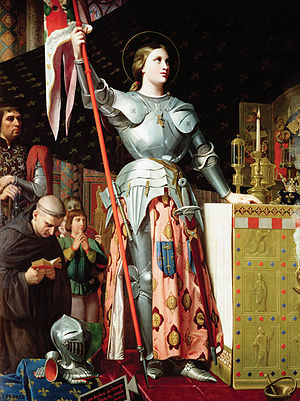Imagine yourself as a child, and imagine being able to hear the voices of the divine, the voices of angels such as Michael the Archangel. Imagine that every time you heard these voices you would see a bright light and you would feel a sense of security. Now imagine that your country had been invaded by those you had been at war with, and these voices came to you and tasked you with the mission to drive that enemy from your land. That was what life was like for young Joan of Arc. She heard the voices of the divine and accepted the challenge to drive out the English from France and to restore her country to what it once was. It was in 1429 when France came face to face with Joan, a young girl, just seventeen years old claiming to hear the voices of angels. Even so, the French knew of her coming because it had been prophesied before she was born, that “France would be ruined by a woman and restored by a virgin from the oak forest of Lorraine.”1

Joan of Arc, born around January of 1412, claimed early in her life that she was divinely inspired to help her country of France in the wake of the political and military turmoil facing her land. When she was in her early teens, she had witnessed a light, soon followed by voices that would speak to Joan with mild commands, “Be good” and “Go to church often.” She had said it was St. Michael who had spoken to her, but he was also accompanied by many angels as well, one of which was St. Gabriel. As she continued to listen to the voices of the divine, she came to realize her purpose, and that purpose was to save her people of France from their enemies. It was 1429 when Joan of Arc heard the voices telling her that it was time to begin her mission, the mission that they had been preparing her for.2
The Hundred Years’ War was a war between the two kingdoms of England and France. It lasted actually for 116 years, beginning in May 1337, and lasting until 1453. The war began when King Edward III of England, the grandson of French monarch Philip IV the Fair, claimed the French throne when the French king Charles IV died without a male heir to the throne.3 Throughout the war, the English had dominated and overpowered France, winning significant battles, such as the Battle of Crecy, the Battle of Agincourt, and the Battle of Poitiers. It was because of these battles and many other victories for England that many believed that the ultimate winner would be the English, and because most of the battles were fought on French territory, France was faced with a destroyed and battered country.

Even so, Joan of Arc was afraid at the enormity of what God was asking her to do. Yet she met His commands with determination and vigor. Joan dressed in male armor and cut her hair as a fallback so that none would be able to tell she was a woman and deny her the opportunity to fight and carry out her mission in the war. With this she took up the sword gifted to her by the angels and began her trek to meet the Dauphin, the yet-to-be-crowned King Charles. Once she came face to face with the Dauphin Charles, Joan of Arc was not immediately recognized as a leader, but she had told the Dauphin that she was sent to him by the voices of God to drive away the English soldiers. Ultimately, she convinced him to let her join the war. The Dauphin soon sent Joan to the Siege of Orleans (October 1428-May 1429).When she arrived, she raised the morale of the troops, allowing the French soldiers to break the siege only nine days later. Soon after, Joan and the French troops went on to take over several English strongholds, and because of the break in the siege and the victories afterward, it allowed the Dauphin Charles VII to march to Reims for his coronation. The siege was the first major victory for the French and the first victory for Joan as well. After the Siege of Orleans, Joan was recognized by King Charles VII as a leader. Joan went on to lead more troops, gaining more victories for France, finally turning the tide of the war.4

That all came to an end, however, when Joan of Arc was captured at Compiegne in May 1430. Upon her capture by English forces, Joan was accused of heresy and witchcraft. On January 9, 1431, her heresy trials began. Joan of Arc had six public examinations and nine private examinations in total. At the end of the trial, the judges composed The Twelve Articles of Accusation, which were the charges accusing her of hearing the voices of the divine and of dressing in men’s clothing, all confirmed by Joan of Arc herself. At the end of the trial, the church’s officials agreed that Joan’s actions and words were evil. They began their final sentence, and Joan agreed to obey all of the rulings made by the Church. She was welcomed back into the Church, but condemned to solitary penance in prison, so she could never commit another crime again. Despite agreeing to begin wearing female clothing again, four days after her sentence, Joan of Arc was seen in prison wearing male clothing, defying the agreed terms of the Church. Soon Bishop Cauchon and seven judges went to Joan of Arc’s cell and questioned her over her wearing men’s clothing. Upon arriving, the Bishop asked why she began wearing men’s clothing again, and she stated, “I had done this on my own free will. Nobody has forced me; I prefer the apparel of a man to that of a woman.”5 When asked why she had done this, she stated that it was more proper to wear men’s clothing than women’s because she was surrounded by men. She also stated that in her time spent in the prison she had been molested by the English when she was wearing women’s attire. The Bishop then asked if she had been hearing the voices of saints again, and when she answered yes, he asked about what they had told her. Joan of Arc had told the Bishop Cauchon that she had endangered her soul by recanting and that she was being condemned because she was trying to save her life. Joan also told him that if God did not want her to recant then she would listen to His word. With this the Bishop stated that she was a “relapsed heretic,” and that the church would have to take legal measures by proceeding “according to law and reason.”6 Joan was charged with relapsing into heresy on May 28,1431, because Joan of Arc had ignored the Church and admitted to hearing the voices of saints and started re-wearing men’s clothing. She was then sentenced to death, to be burned at the stake two days later, on May 30.7

During and after Joan of Arc’s trial, the French forces became timid and soft, but ultimately won the war in 1453. After the war, King Charles VII ordered a review of Joan of Arc’s trial, even though the Roman Catholic Church did not formally begin the canonization process till 1869 and even then was not declared a saint for another fifty years.8 France celebrated and recognized Joan as a national hero because Joan of Arc fulfilled the prophecy that was foretold, listened to the premonitions she received from God, and never strayed from her beliefs. The French believe she was a key factor in the war because she came to France’s aid when they were at their breaking point. Joan of Arc broke the Siege of Orleans and pushed the English back, allowing France to reclaim what they had lost. She is a hero not only of France, but she is a representation of courage and independence and to this day continue to celebrate her life and her legacy.9
- Soren Bie, “Prophecies,” Joan of Arc (Jeanne D’Arc) 1412 – 1431, 9 July 2017, www.jeanne-darc.info/biography/prophecies/. ↵
- Kathryn Harrison, Joan Of Arc: A Life Transfigured (New York: Doubleday, 2014) 1, 17-20. ↵
- World History Encyclopedia, 2011, s.v. “The Hundred Years’ War,” by Alfred J. Andrea. ↵
- Julien Thery “How Joan of Arc Turned the Tide in the Hundred Years’ War,” National Geographic, April 13, 2017, https://www.nationalgeographic.com/archaeology-and-history/magazine/2017/03-04/joan-of-arc-warrior-heretic-saint-martyr/. ↵
- Julien Thery, “How Joan of Arc Turned the Tide in the Hundred Years’ War,” National Geographic, April 13, 2017, https://www.nationalgeographic.com/archaeology-and-history/magazine/2017/03-04/joan-of-arc-warrior-heretic-saint-martyr/. ↵
- Julien Thery “How Joan of Arc Turned the Tide in the Hundred Years’ War,” National Geographic, April 13, 2017, https://www.nationalgeographic.com/archaeology-and-history/magazine/2017/03-04/joan-of-arc-warrior-heretic-saint-martyr/. ↵
- Craig Taylor, Joan of Arc: La Pucelle (New York: Manchester University Press, 2006), 205, 207, 216, 220, 222. ↵
- Mary Gordon, Joan of Arc (New York: Lipper/Viking, 2000), 166. ↵
- Julien Thery “How Joan of Arc Turned the Tide in the Hundred Years’ War,” National Geographic, April 13, 2017, https://www.nationalgeographic.com/archaeology-and-history/magazine/2017/03-04/joan-of-arc-warrior-heretic-saint-martyr/. ↵



40 comments
Matthew Swaykus
This author’s style of writing is very engaging for readers and differs from most articles I have seen on this website. The author challenges the readers of this article with realizing the enormity of Joan of Arc’s situation. We read stories about men and women who are prophesized to do great things, but we never considered the possibility of this occurring within our own lives. We never truly grasp how earth-shatteringly incredible, humbling and terrifying that would be to anyone.
Noah Bolhuis
As someone that grew up in and around a Catholic Church parish named Saint Joan of Arc, I felt that I am decently well educated on Saint Joan of Arc’s story; but it turns out I only knew the minimal. Knowing that she was a knight for the Catholic Church and of France, I grew a grew respect for her. Later learning and understanding that she was a martyr burned at the stake, I grew an even deeper respect and appreciation for her. This article was very well written, and gave a better insight on her story.
Kristy Feather
Ever since I was young I always felt like Joan of Arc was a woman I wanted to know. Knowing that she fought and died for her beliefs. She was a martyr, but most of all she was a warrior and a knight in every sense of the word. But most of all she was also a true saint for being willing to follow the directions of God.
Dylan Coons
Articles like this are so important. Being able to see that men were not the only ones that fought in battles. While history tends to focus on what men have done, we often forget all the good women heroes did throughout the history of mankind. Joan of the Arc is a great example of that and is yet another story demonstrating that women can do anything a man can do.
Jocelyn Moreno
Wow, my church is named after this saint and I never knew anything about who she is or what she has done. She is very inspirational, coming to show that with God by your side anything and everything is possible. It’s so sad to hear that the very reason she died was that her inability to lose her faith. I learned so much about Joan of Arc, this article was very interesting and informative!!!
Hailey Stewart
I have never heard the story of Joan of Arc, and now I understand why she is loved by so many. Her story is one of courage and individuality. I think it is interesting that stories of women dressing in men’s clothing to fight battles can be found across many different cultures. I really liked reading this narrative. Great article!
Pamela Callahan
I choose to read this article because Joan of Arc is my confirmation saint. I found her story to be very interesting and I find her unconditional faith in God to be inspirational. For her to be have so much faith even from such a young age is not a normal occurrence, and in hearing about her story the first time I thought that she would be a perfect saint for me to choose. I also look up to her as a model for the way that I should live my life; with unquestioning faith and unwavering obedience to God’s will.
Steven Hale
Living in modern times, many of us, of course, associate hearing voices with a medical illness, while people in Joan of Arc’s time saw it either as a spiritual gift or heresy. It seems really surprising that she was able to talk her way into a leadership position in the Army, despite not being a career soldier or a noble; I suppose that indicates just how charismatic and well-spoken she was.
Madison Downing
I have always loved the story of Joan of Arc because of the supernatural characteristics in the true tale. She managed to pass off as a male and rallied the troops to push the British back from their land. It was terrible how she died just because she never EVER lost her faith in God and her purpose. I wish there were more people like her in the world but not everyone can be apart of a prophecy! I actually never knew about that part and that makes her life so much more beautiful! She died too young and I’m so happy that France still honors her to this day.
Mariana Valadez
I had no prior knowledge about Joan of Arc before reading this. She was gifted with extreme authority. I find it interesting how she led an entire army. She is very inspirational. She is a fearless leader and a great representation of what women can do. I loved reading this and was gifted with many new knowledges. Great article to read!